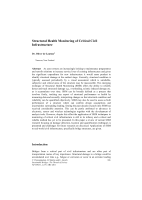Bridges

- Publication no: ABC-AAI012-11
- Published: 31 October 2011
- PDF (free) Download
As asset owners are increasingly looking to maintenance programmes and retrofit solutions to increase service lives of existing infrastructure and given the significant expenditure for new infrastructure it would seem prudent to identify structural damage at the earliest stage. Currently, structural condition is typically assessed periodically by a visual assessment which is unreliable, subjective and critical areas of the structure may be inaccessible. The emerging technique of Structural Health Monitoring (SHM) offers the ability to reliably detect and track structural damage e.g., overloading, seismic induced damage etc. as it accumulates over time. SHM can be broadly defined as a process that involves firstly, tracking any aspect of structural performance or health by measuring data and secondly, interpreting changes so that structural condition and reliability can be quantified objectively. SHM may also be used to asses as built performance of a structure which can confirm design assumptions and uncertainties surrounding loading. During the past decade research into SHM has received considerable attention. This can be partly attributed to advances in electronic, sensor and wireless technologies together with the development of analysis tools. However, despite this effort the application of SHM techniques to monitoring of critical civil infrastructure is still in its infancy and a robust and reliable method has yet to be presented. In this paper a review of current SHM research focusing on damage detection, location and quantification techniques is presented and challenges for future research are discussed. Applications of SHM to real-world civil infrastructure, specifically bridge structures, are given.
